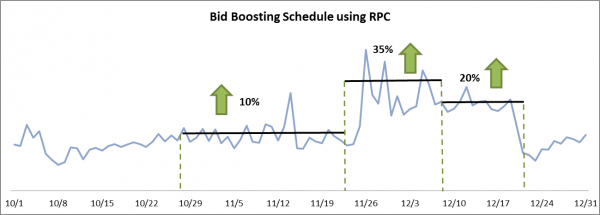3 Tips Key To 2011 Holiday Advertising
Last holiday season, online consumers spent approximately $32.6 billion, a 12 percent increase from 2009. We can safely assume the trend will continue in 2011 as shoppers’ propensity to search online for the best deals grows and retailers respond by bulking up their online offers. As a result, competition among online retailers will be at […]
Last holiday season, online consumers spent approximately $32.6 billion, a 12 percent increase from 2009. We can safely assume the trend will continue in 2011 as shoppers’ propensity to search online for the best deals grows and retailers respond by bulking up their online offers. As a result, competition among online retailers will be at an all-time high this holiday season.
Our own research also indicates shoppers will likely begin their search for holiday gifts earlier than in previous years. According to our findings, four of the top five days for paid search conversions in 2010 occurred in November, a shift that is expected to continue.
As a result, search marketers need to begin their campaigns earlier this year and need to retain more flexibility in their campaigns to capitalize on any shifts in online shopper behavior.
To help prepare for the upcoming holiday season and get the most out of your 2011 holiday ad campaigns, here are three best practices to consider:
Create A Boost Schedule
Unfortunately, no one has a crystal ball to precisely predict shifts in consumer spend; however, it’s more probable than not that the 2011 holiday season will resemble last year.
Using 2010 revenue per click (RPC) trends as a guide, search marketers can anticipate when purchasing behavior is most likely to increase and develop a “boost schedule” as part of their bidding strategy.
Similar to a roadmap, a boost schedule helps marketers determine when and how much to increase keyword bids, enabling retailers to budget more accurately and take advantage of higher conversion rates during peak times.
For example, by looking at 2010 trends and setting Oct. 1 as the a RPC baseline rate, a marketer determines the average RPC rate increased 10% during the first three weeks of November, 35% the last week of November and the first week of December, and 20% from the baseline in the last three weeks of December.
The marketer can then estimate accordingly to increase bidding in 2011 by 10%, 35% and 20% during the same time periods to stay in line with varying conversion rates.
A boost schedule can be as granular as a search marketer wants and can map out changes to bid levels on a weekly or daily level. Once the holiday season ends, however, marketers need to be sure to reset bid levels back to the baseline.
Manage Bids To Inventory
Cost-cutting measures in recent years have resulted in leaner inventories for many retailers, making it more important than ever to manage according to changing inventory levels. Search marketers should monitor inventory levels on a regular basis and pause relevant keywords when approaching a stock-out scenario.
Typically, items with a limited selection available experience a decrease in conversion rates. Marketers should set alerts to identify dramatic drops in conversion rates, which may indicate a reduction in inventory.
Dampening bids or pausing keywords when advertisers reach a low inventory or limited selection situation will ensure retailers don’t pay for costly clicks that don’t convert.
Develop A Mobile Strategy
Consumers are increasingly using mobile phones to find deals and compare prices on the go. In fact, Google recently predicted 44% of last-minute searches for gifts this year will be done on a mobile device.
A well-thought mobile strategy should be part of every online marketer’s holiday ad program this year, and a comprehensive mobile strategy should start by separating out mobile campaigns from desktop or tablet oriented campaigns.
Creating separate mobile campaigns offers several advantages. For one, ad position is much more important in mobile devices where real estate is limited. To increase mobile response rates, marketers can leverage position-based bidding to ensure ads are showing above the fold.
Another benefit of having separate campaigns is advertisers can show location extensions within the ad creative and quickly point mobile shoppers to the nearest store location, which can make all the difference, especially for the last-minute shopper.
As we step closer to the holiday season, are there any other strategies you’ve found to be successful in preparing or implementing holiday campaigns?
Opinions expressed in this article are those of the guest author and not necessarily Search Engine Land. Staff authors are listed here.
Related stories
New on Search Engine Land

